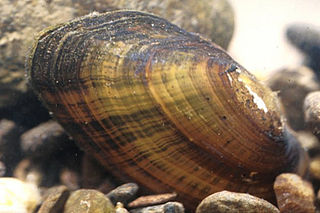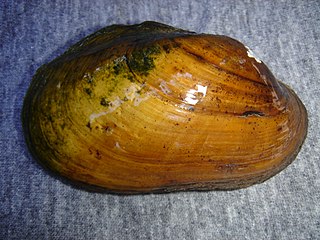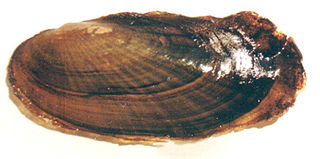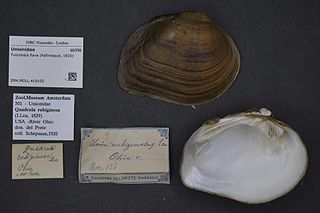
The dwarf wedgemussel is an endangered species of freshwater mussel, an aquatic bivalve mollusk in the family Unionidae, the river mussels.

The Unionidae are a family of freshwater mussels, the largest in the order Unionida, the bivalve molluscs sometimes known as river mussels, or simply as unionids.
Alasmidonta atropurpurea, common name Cumberland elktoe, is a species of freshwater mussel, an aquatic bivalve mollusk in the family Unionidae, the river mussels.

Unionida is a monophyletic order of freshwater mussels, aquatic bivalve molluscs. The order includes most of the larger freshwater mussels, including the freshwater pearl mussels. The most common families are the Unionidae and the Margaritiferidae. All have in common a larval stage that is temporarily parasitic on fish, nacreous shells, high in organic matter, that may crack upon drying out, and siphons too short to permit the animal to live deeply buried in sediment.

The elktoe is a species of freshwater mussel, an aquatic bivalve mollusk in the family Unionidae, the river mussels. This species is found in southeastern Canada and the eastern United States. Like many mussels, it is threatened by water pollution from agriculture, industry, and other development, such as acid mine drainage and sedimentation. It may be extinct in Oklahoma.

The Appalachian elktoe is a species of freshwater mussel in the family Unionidae, the river mussels. It is native to the United States, where it is known only from North Carolina and Tennessee.

Lampsilis abrupta, the pink mucket or pink mucket pearly mussel, is a species of freshwater mussel, an aquatic bivalve mollusk in the family Unionidae, the river mussels. This species is endemic to the United States.

Hamiota altilis, the finelined pocketbook, is a species of freshwater mussel, an aquatic bivalve mollusk in the family Unionidae, the river mussels.

Lampsilis higginsii is a rare species of freshwater mussel known as Higgins' eye pearly mussel or simply Higgins' eye. It is endemic to the United States, where it occurs in the upper Mississippi River and the drainages of some of its tributaries. It is threatened by the introduced zebra mussel. Lampsilis higginsii is a federally listed endangered species.

Hamiota perovalis, the orangenacre mucket or orange-nacre mucket, is a species of freshwater mussel, an aquatic bivalve mollusk in the family Unionidae, the river mussels.

Lampsilis powellii is a rare species of freshwater mussel known by the common name Arkansas fatmucket. It is endemic to Arkansas in the United States, where it occurs in the Ouachita, Saline, and Caddo River systems. It is one of two mussels endemic to Arksansas, the other being speckled pocketbook. It is a federally listed threatened species of the United States.

Potamilus leptodon, the scaleshell mussel or scale shell, is a species of freshwater mussel in the family Unionidae, the river mussels. This aquatic bivalve mollusk has disappeared from much of its historical range. It is endemic to the United States, where it is now present in four or fewer states; it is only found with any regularity in Missouri. It is a federally listed endangered species of the United States.
The triangular kidneyshell is a species of freshwater mussel, in the family Unionidae, the river mussels. It is endemic to Alabama in the United States, where it is known from several rivers and streams in the Mobile River Basin. It is a federally listed endangered species of the United States.
Freshwater bivalves are molluscs of the order Bivalvia that inhabit freshwater ecosystems. They are one of the two main groups of freshwater molluscs, along with freshwater snails.

Paetulunio fabalis, the rayed bean, is a species of freshwater mussel, an aquatic bivalve mollusk in the family Unionidae, the river mussels. It is the only species in the genus Paetulunio, and was formerly classified in Villosa until a 2018 study.

The shinyrayed pocketbook is an endangered species of freshwater mussel in the family Unionidae, the river mussels. This species is endemic to the United States in the states of Georgia, Florida, and Alabama.
Obovaria arkansasensis, the Southern Hickorynut, is a species of freshwater mussel, an aquatic bivalve mollusc in the family Unionidae, the river mussels. It lives in the southern United States, and has a complex life history including its larvae being parasitic on a fish host.

Fusconaia flava, the Wabash pigtoe, is a freshwater mussel in the family Unionidae. This species occurs in southern Manitoba and Ontario, Canada as well as in the eastern and midwestern United States from North Dakota to New York, south to Mississippi and Texas.
Sinanodonta beringiana, the Yukon floater, is a freshwater mussel, an aquatic bivalve mollusk in the family Unionidae, the river mussels.

Hamiota australis, the southern sandshell, is a species of freshwater mussel, an aquatic bivalve mollusc in the family Unionidae, the river mussels.
















